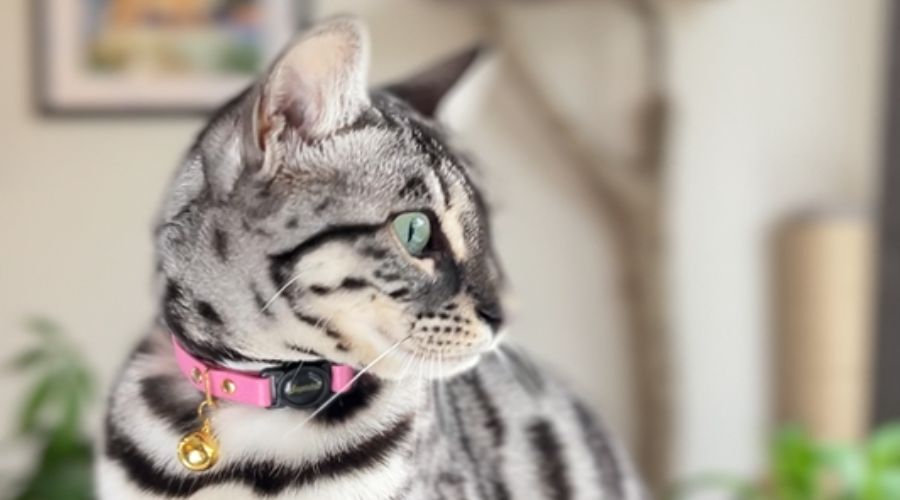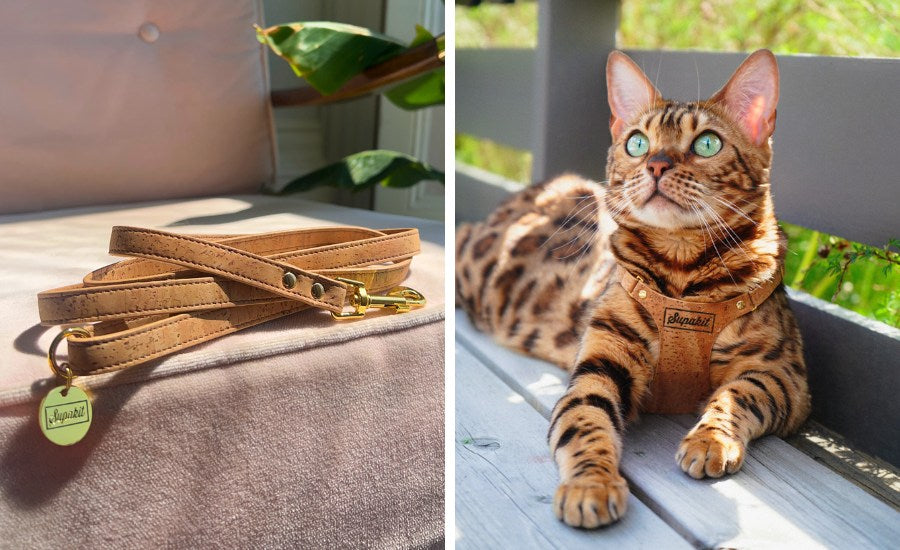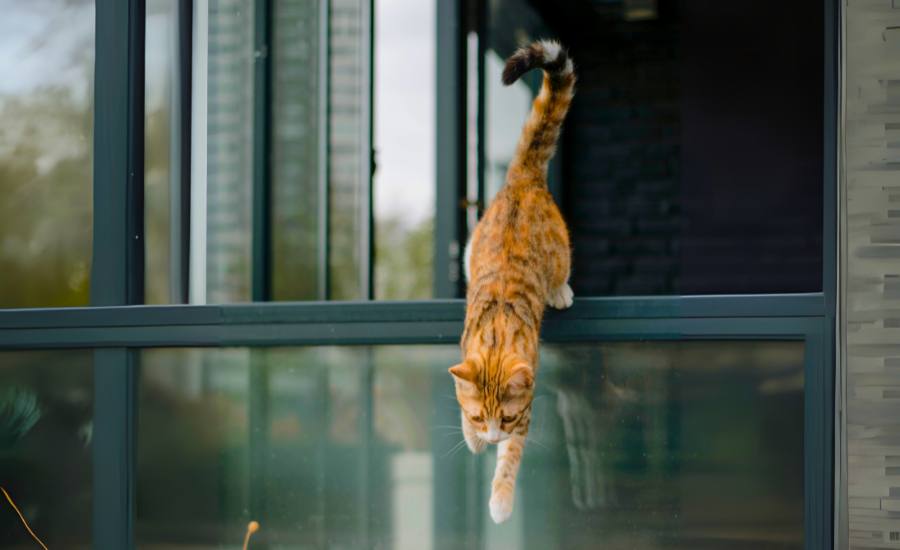Should You Put a Bell On Your Cat's Collar?
Bells on cat collars can be a controversial topic in the cat community as there isn’t a one-size-fits-all answer. What's right for your cat depends on the environment you live in, your cat's behaviour, their lifestyle and temperament.
Here at Supakit, we support every member of our community to cater to their cat’s unique needs. That’s why all of our cat collars come with detachable bells, so the choice is always yours. Let’s learn more about cat bell collars to help you make the best decision for your kitty.
Scroll down to keep reading or watch our episode about collar bells on YouTube.
Why Do Cat Collars Have Bells?
Bells Can Help You Locate Your Cat
Cats are stealthy creatures that get into all sorts of unexpected hiding places. Cat collars with bells can help you find your kitty in a large house, garden, or hidden up a tree.
Members of our community who have disabled cats tell us that bells are very helpful. Disabled cats are at greater risk of getting trodden underfoot or sat on, as they can’t easily get out of the way. A cat collar with a bell lets owners know their kitties are nearby.
A kitten collar with a bell can help keep young cats safer too. Kittens are notorious for squeezing through spaces they shouldn’t and getting trapped. Bells can help owners keep track of their adventurous kittens.
Bells Can Reduce Cat Fights
Cats are territorial animals with complex social lives and sometimes get into fights. While this is natural behaviour, it isn’t nice and aggression between cats in a household can result in injury. Cat bell collars could reduce conflicts by letting gentler cats in a household know when a dominant kitty is nearby.
Bells Can Reduce Predation On Wildlife
Cats are excellent hunters and have helped us keep pests like mice under control for millennia. Unfortunately, as humans have colonised the far reaches of the globe our cats have also impacted populations of birds, mammals, and reptiles (1).
In some places, such as island nations (2), it is important to keep your pet cat indoors. This prevents them from killing wildlife that did not evolve with feline predators. In others, cats roam freely and cat collars with bells are a popular way of reducing the negative effect on wildlife.
There is some contention as to how effective bell collars are. Some studies show no reduction in predation at all (3). However, most conclude that bells lead to a significant reduction in predation (4), and could cut down kills by more than half (5).
Many people also claim that cats change their hunting behaviour to prevent the bell chiming. In reality, it has been demonstrated that bells not only reduce kills, but that cats do not adapt to the presence of bells over time (6).
Alternatives To Cat Collar Bells To Reduce Predation
There are some excellent alternatives to bells that can reduce your cat’s impact on wildlife. The Birdsbesafe cover is a bright fabric frill that slides over your cat’s breakaway collar. It can significantly reduce bird kills (7) and minimise predation of amphibians and reptiles (8). It is not so effective on mammals (8), so is ideal if you want to prevent bird deaths, but rely on your cat as a mouser.
Altering your cat’s diet can also reduce hunting (9). Giving your cat a grain-free, high-meat diet can reduce predation by up to 36%. Engaging in mock-hunting play with your kitty for only 10 minutes a day also has a big impact, and could result in 25% fewer kills being brought home.
Are Cat Collars With Bells Bad For Cats?
The well-being of our cats is a huge priority. We want to protect wildlife, but many of us are afraid that we could endanger our kitties by making them wear a collar with a bell.
Bells Could Put Your Cat In Danger From Other Predators
In some parts of the world, cats that roam outdoors are in danger of becoming prey to coyotes, wolves, or other large predators. Wearing a cat bell could make your kitty more vulnerable to attack as they are more likely to be noticed and less able to hide. If you live in an environment like this, the only real way to protect your cat is to keep them indoors.
Bells Could Cause Anxiety For Your Cat
If your cat is a nervous and reactive individual, a bell may not be a good idea. The tinkling of the bell every time they move could cause stress and anxiety. Luckily, most cats tolerate a bell well and don’t show signs of annoyance. Try introducing the bell after your cat has become accustomed to wearing a collar (you can follow our collar introduction guide here) to help them get used to it in stages.
Do Bells Hurt Cat Ears?
The good news is that the low volume of a bell (~50 dB) is not loud enough to cause physical damage to your cat’s ears. This means that the quiet tinkle of a cat bell could not cause issues such as hearing loss or tinnitus, as can happen when people attend rock concerts.
However, a series of studies (10) by researchers Pienkowski and Eggermont are uncovering that consistent exposure to moderate-level sounds can affect cats. They found that prolonged exposure led to reduced responsiveness of the auditory cortex to sound within the tested range.
This doesn’t necessarily mean that cat bells are harmful. But, after a while, your cat’s brain will screen out the tinkling of their bell. This may make them less aware of similar sounds too, and reduce their responsiveness to some noises as a result.
Related posts: 'Does My Cat Need An ID Tag?' and 'Should You Put A Collar On Your Cat?'
References
- The Impact of Domestic Cat (Felis Catus) on Wildlife Welfare and Conservation: A Literature Review. 2003.
- Duffy, D. C., & Capece, P. (2012). Biology and Impacts of Pacific Island Invasive Species. 7. The Domestic Cat (Felis catus). In Pacific Science (Vol. 66, Issue 2, pp. 173–212). Pacific Science. https://doi.org/10.2984/66.2.7
- Mori, E., Menchetti, M., Camporesi, A., Cavigioli, L., Tabarelli de Fatis, K., & Girardello, M. (2019). License to Kill? Domestic Cats Affect a Wide Range of Native Fauna in a Highly Biodiverse Mediterranean Country. In Frontiers in Ecology and Evolution (Vol. 7). Frontiers Media SA. https://doi.org/10.3389/fevo.2019.00477
- Nelson, S. H., Evans, A. D., & Bradbury, R. B. (2005). The efficacy of collar-mounted devices in reducing the rate of predation of wildlife by domestic cats. In Applied Animal Behaviour Science (Vol. 94, Issues 3–4, pp. 273–285). Elsevier BV. https://doi.org/10.1016/j.applanim.2005.04.003
- Gordon, J. K., Matthaei, C., & van Heezik, Y. (2010). Belled collars reduce catch of domestic cats in New Zealand by half. In Wildlife Research (Vol. 37, Issue 5, p. 372). CSIRO Publishing. https://doi.org/10.1071/wr09127
-
Ruxton, G. D., Thomas, S., & Wright, J. W. (2002). Bells reduce predation of wildlife by domestic cats ( Felis catus ). In Journal of Zoology (Vol. 256, Issue 1, pp. 81–83). Wiley. https://doi.org/10.1017/s0952836902000109
- Willson, S. K., Okunlola, I. A., & Novak, J. A. (2015). Birds be safe: Can a novel cat collar reduce avian mortality by domestic cats (Felis catus)? In Global Ecology and Conservation (Vol. 3, pp. 359–366). Elsevier BV. https://doi.org/10.1016/j.gecco.2015.01.004
-
Hall, C. M., Fontaine, J. B., Bryant, K. A., & Calver, M. C. (2015). Assessing the effectiveness of the Birdsbesafe® anti-predation collar cover in reducing predation on wildlife by pet cats in Western Australia. In Applied Animal Behaviour Science (Vol. 173, pp. 40–51). Elsevier BV. https://doi.org/10.1016/j.applanim.2015.01.004
- Cecchetti, M., Crowley, S. L., Goodwin, C. E. D., & McDonald, R. A. (2021). Provision of High Meat Content Food and Object Play Reduce Predation of Wild Animals by Domestic Cats Felis catus. In Current Biology (Vol. 31, Issue 5, pp. 1107-1111.e5). Elsevier BV. https://doi.org/10.1016/j.cub.2020.12.044
- Pienkowski, M., & Eggermont, J. J. (2010). Passive exposure of adult cats to moderate-level tone pip ensembles differentially decreases AI and AII responsiveness in the exposure frequency range. In Hearing Research (Vol. 268, Issues 1–2, pp. 151–162). Elsevier BV. https://doi.org/10.1016/j.heares.2010.05.016









